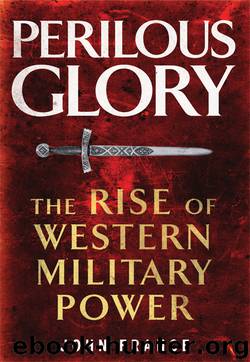Perilous Glory by John France

Author:John France
Language: eng
Format: epub
ISBN: 9780300120745
Publisher: Yale University Press
WAR in the second half of the nineteenth century was transformed by two interacting forces – the French Revolution with its ideas of nationalism and democracy, and the huge surge in industrial development. This last gave rise to an extraordinary technological revolution which utterly changed the conduct of war. In 1854 Britain went to war against Russia with a fleet of ‘wooden walls’. In 1906 she launched HMS Dreadnought, a steel battleship of 17,900 tons capable of 21.6 knots and carrying ten 12-in. guns with ranges of over 12,000 metres. The science of hydraulics which governed the movement of her guns and the optics which made it possible to aim them barely existed in 1856. In 1900 a single British battalion of 600 had more firepower than all the 60,000 who fought at Waterloo in 1815. The internal combustion engine, though as yet crude, promised quick and flexible road transport. In 1903 the Wright brothers flew the first heavier-than-air machine and by 1912 Russian army field manoeuvres enlisted eight aircraft, bringing an entirely new dimension to war.
Populations grew enormously in Europe from 187 million in 1800 to 400 million by 1900, and in the US for the same period from 5.3 million to 76.2 million. This vast increase created the potential for larger armies, which could be realised because the means to supply and maintain them had radically improved. During the Revolutionary and Napoleonic Wars forces of 70,000 were commonplace and occasionally, in battles like Wagram and Borodino, both sides mustered over 100,000. Leipzig, 16–19 October 1813, was extraordinary in that Napoleon's army of 190,000 faced an allied force of 365,000. At Gettysburg in the American Civil War, 1–3 July 1863, 70,000 Confederates were defeated by 90,000 Unionists. In 1914 the French had a standing army of 823,000 with 2.9 million reserves and the Germans 700,000 with 3.8 million reserves. Such was the scale of armies and so great their firepower that the author of The Future of War, I.S. Bloch, was not alone in thinking that war was now so terrible as to be unthinkable. And in fact leading soldiers were at least as confused as anybody else by the new means of war which technology was putting in their hands.
The key commodity of the ‘Second Industrial Revolution’ after 1870 was cheap high-quality steel which could be drilled, cut and worked by its characteristic product, the machine tool. The dyestuffs and chemical industry became important, along with electricity, optics and hydraulics. The telephone and later the wireless offered ever faster communication. The generals were no longer the force driving military innovation, as entrepreneurs, often by dazzling salesmanship and bribery, imposed their new weapons on armies. In 1849 the Prussian Alfred Krupp, ‘the Cannon King’, delivered an all-steel breech-loading cannon to the Prussian army, only for it to be left out in the rain to rust for nearly two years. But at the London Great Exhibition in 1851 he exhibited a cast-steel ingot of 2,000 kg, more than twice as big as any yet made, and with it his new cannon.
Download
This site does not store any files on its server. We only index and link to content provided by other sites. Please contact the content providers to delete copyright contents if any and email us, we'll remove relevant links or contents immediately.
| Africa | Americas |
| Arctic & Antarctica | Asia |
| Australia & Oceania | Europe |
| Middle East | Russia |
| United States | World |
| Ancient Civilizations | Military |
| Historical Study & Educational Resources |
The Radium Girls by Kate Moore(11619)
100 Deadly Skills by Clint Emerson(4688)
The Templars by Dan Jones(4556)
Rise and Kill First by Ronen Bergman(4543)
The Doomsday Machine by Daniel Ellsberg(4243)
The Rape of Nanking by Iris Chang(4021)
Killing England by Bill O'Reilly(3896)
Hitler in Los Angeles by Steven J. Ross(3797)
Stalin by Stephen Kotkin(3724)
12 Strong by Doug Stanton(3418)
Hitler's Monsters by Eric Kurlander(3161)
Blood and Sand by Alex Von Tunzelmann(3055)
Darkest Hour by Anthony McCarten(3017)
The Code Book by Simon Singh(2855)
The Art of War Visualized by Jessica Hagy(2836)
Hitler's Flying Saucers: A Guide to German Flying Discs of the Second World War by Stevens Henry(2621)
Babylon's Ark by Lawrence Anthony(2427)
The Second World Wars by Victor Davis Hanson(2419)
Tobruk by Peter Fitzsimons(2373)
